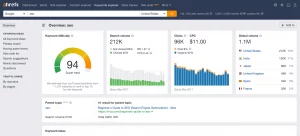SEO Fundamentals for Dropshipping: Optimizing Product Pages for Higher Search Visibility

If you’re a dropshipper, you know that getting your products seen online is key. But with so many other sellers out there, how do you make yours stand out? And here, SEO, or Search Engine Optimization, play a key role.
It’s about making your product pages extra appealing to search engines like Google. And with a few smart strategies, you can boost your products higher in search results and get way more eyes on them.
So, here, we’ll guide you about the essentials of SEO for dropshipping product pages so you can start attracting those organic clicks.
How to Optimize Product Pages for Dropshipping SEO
Optimizing product pages for search engines isn’t just about technical tricks — it’s about presenting your products in a way that both search engines and your target customers will love, says Alex Taylor, Head of Marketing at Digital Signage New York.
So, let’s get into the key strategies.
Conduct Thorough Keyword Research
Eran Mizrahi, CEO of Ingredient Brothers, says, “Choosing the right keywords is the foundation of successful product page SEO.”
To find the phrases that your potential customers actually use, you’ll need these tools.
Your Brain
Sometimes, our brain works like a tool. Simply start by brainstorming a list of words and phrases you’d likely use if you were searching for the product yourself. Consider different variations, features customers might look for (color, size, material), and synonyms that mean essentially the same thing.
Google Keyword Planner
This free tool within your Google Ads account is a great starting point. It allows you to see how often people search for specific keywords, how competitive they are (how many other websites are targeting them), and get suggestions for related keywords.
Ahrefs or Semrush

Chase Hughes, Founder of ProAI, explains, “Ahrefs or Semrush are paid SEO tools that offer a more in-depth look at keywords. They’ll help you analyze what keywords your competitors are ranking for, get even more long-tail keyword suggestions, and see detailed search volume data.”
Why Long-Tail Keywords Matter for Dropshipping
While targeting generic keywords like “sweatshirt” might be tempting, those are incredibly competitive. As a dropshipper, you’ll get better results focusing on long-tail keywords. These are longer, and more specific phrases, like “oversized pink hoodie for women.”
They might have less search volume individually, but they’re less competitive, meaning you have a greater chance of ranking for them. Plus, people searching with long-tail keywords are often further along in their buying decision and closer to making a purchase.
Write Unique, Compelling Product Descriptions
One of the biggest hurdles with dropshipping is that you’re often using the same manufacturer-provided product descriptions as countless other stores. This leads to duplicate content, which search engines dislike, adds Martin Seeley, CEO of Mattress Next Day.
More importantly, it doesn’t help you stand out from the crowd. Here’s how to write descriptions that sell and please the search engines.
Go Beyond the Specs
Sure, list the essential features of the product, but don’t stop there. Paint a picture of how this product will solve a problem for the customer or enhance their life. Will it make them more comfortable? More stylish? More organized? Focus on the benefits rather than just listing features.
Use Your Brand Voice
Is your brand fun and playful? Luxurious and sophisticated? Let your personality shine through in your descriptions. This helps differentiate you from generic product listings.
Naturally Incorporate Keywords
While you don’t want to awkwardly stuff keywords in, weave your target phrases into the description where they flow organically.
Aim for Readability
Yes, you want your descriptions to be informative, but avoid giant walls of text. Use formatting, short paragraphs, and maybe even a few bullet points to make it easy on the eyes.
Danny Jay, Marketing Director at SOLVED Consulting, adds, “A great product description is like a mini-salesperson working for you 24/7. It should inform, excite, and ultimately persuade someone to click that “Add to Cart” button.”
Optimize Title Tags and Meta Descriptions
Title tag and meta description is your product’s advertisement within search results. They’re what convince people to click on your listing instead of the dozens of others.
So, here’s how to make them count.
Title Tag
This is arguably the most important SEO element on your page. Keep it under 60 characters and include your primary keyword near the beginning. Craft it like a compelling headline, enticing people to learn more.
Meta Description
This is the short snippet of text that appears under your title in search results. Aim for 150-160 characters and use it to expand on your title tag. Include a call to action (e.g., “Shop now”, “Discover more”), says Saba Mobebpour, CEO at DropGenius.
Let me show you an example.
Let’s say you sell yoga mats. Here’s a weak vs. strong title tag and meta description.
- Weak Title Tag: Yoga Mat
- Weak Meta Description: Blue yoga mat for sale.
- Strong Title Tag: Extra Thick Yoga Mat — Non-Slip Support for Your Practice
- Strong Meta Description: Upgrade your yoga flow with our 6mm thick, non-slip mat. Perfect for all levels. Shop now and get free shipping!
The example clearly targets the relevant keyword, highlights the benefits, and entices the searcher to click for more information.
Use High-Quality Product Images
Humans are visual creatures. William Westerlund, SEO Expert at Tradeit.gg, explains, “Great product images aren’t just about making your page look pretty — they directly impact how people perceive your products (and your store’s professionalism!). Here’s what to keep in mind.”
Professional Look
If possible, invest in professional product photography. If that’s not in the budget, learn some basic DIY product photography techniques. Good lighting and a clean background make a world of difference.
Multiple Images
Don’t rely on just one photo. Include multiple images showcasing the product from different angles, in use, or highlighting special details.
Image Optimization
Before uploading, give your images descriptive file names (instead of generic ones like “IMG_00123.jpg”). An example might be “blue-yoga-mat-close-up-texture.jpg.” Also, compress the images to reduce file size for faster page load times.
Alt Text
This is the text description that shows if an image fails to load, and it’s essential for screen readers. Briefly describe the image and include relevant keywords where natural (e.g., “Extra thick blue yoga mat with non-slip texture”).
Alison Lancaster, CEO of Pressat.co.uk, adds, “If your product has variations (colors, sizes), include images clearly showcasing each option. This enhances the user experience and reduces the chance of misunderstandings leading to returns.”
Utilize Product Reviews and Ratings

Reviews are like built-in salespeople for your product pages! They do several important things.
- Build Trust: Positive reviews and ratings provide social proof, reassuring potential customers that others have had a good experience with your product and brand.
- Add Unique Content: Reviews often contain specific keywords and details about the product, which can further improve your SEO.
- Influence Search Results: Search engines may factor reviews and ratings into their ranking algorithms. Plus, products with star ratings can stand out more in search results.
How to Encourage Reviews
Here’s how you can encourage customers for reviews.
- Make it Easy: Have a clear way for customers to leave reviews directly on your product pages.
- Follow-up: Send post-purchase emails asking customers to review the product. You can even offer a small incentive (like a discount code) to increase participation.
- Address the Negative: Don’t just ignore bad reviews. Respond publicly and professionally, offering solutions whenever possible. This shows potential customers that you care about customer experience.
Even a few high-quality reviews make a big difference on a product page. Encourage those happy customer testimonials!
Create a Seamless Mobile Experience
With more people shopping from their smartphones than ever before, optimizing your product pages for mobile isn’t optional — it’s essential. Here’s how to ensure your customers have a smooth experience, no matter what device they’re on.
Responsive Design
Invest in a dropshipping store theme that automatically adjusts its layout for different screen sizes. This means your product images, text, and buttons will look great whether someone’s on a desktop, tablet, or phone.
Touch-Friendly Layout
Are your “buy” buttons easily tappable with a finger? Can your customers comfortably read text without excessive zoom? Small design details make a big difference on mobile.
Image Optimization
Ensure your product images load quickly on mobile connections. Overly large files are a major cause of slow load times and abandoned carts. Use image compression tools without sacrificing quality.
Simplify Navigation
A cluttered menu looks even worse on a small screen. Keep your mobile navigation streamlined, with clear categories and easy-to-find search functionality, adds Alex Begum, San Antonio Injury Lawyer at VB Law Group.
Prioritize Speed
Mobile shoppers are impatient. Use tools like Google’s PageSpeed Insights to analyze your store’s mobile load time and identify areas for improvement.
Test, Test, Test
Never assume your site looks great on all devices. Check it yourself on different phones and tablets. Ask friends for help with testing and provide honest feedback!
Additional Factors to Consider for Dropshipping Product Page SEO
While the tips we’ve covered will give you a strong SEO foundation, now let’s dig into some additional aspects that can give your product pages an extra boost.
URL Structure
Clean, keyword-inclusive URLs are liked by both search engines and humans. They help people understand what the page is about before they even click.
Instead of a messy URL filled with random numbers and parameters. If possible, include your target keyword in the product-name part of the URL. Your dropshipping ecommerce platform should give you control over how your URLs are structured.
Internal Linking
Internal linking means strategically linking between pages within your own website. It helps search engines understand the structure of your site and discover all your important pages, says Gerrid Smith, CMO of Joy Organics.
Here’s how to use internal linking effectively for product page SEO.
- Product to Product: Link between related products within your descriptions (e.g., if you sell yoga mats, link to other yoga gear on that product page).
- Blog to Product: If you have a blog, link to relevant products naturally within your article content. For example, a blog about yoga poses could link to your yoga mat product page.
Keep in mind, the text you use for your internal links (anchor text) matters too! Instead of just saying “click here”, use a descriptive phrase that includes keywords (e.g., “Shop our selection of colorful yoga mats”).
Schema Markup
Usama Khan, manager at Justreply, said, “Schema markup is a type of code (structured data) that you can add to your product pages. It essentially gives search engines more detailed information about your products, like price, availability, star ratings, and more.
This can lead to what’s called “rich snippets” in search results — those eye-catching listings with extra details. While implementing schema can be a bit technical, there are plugins and apps that can simplify the process for your dropshipping store. The potential payoff for improved search visibility is worth exploring.”
Conclusion
SEO is an ongoing process. By implementing the strategies we discussed, you’ll put your dropshipping product pages on the path to attracting more organic search traffic.
Start with a few key changes, track your results, and keep tweaking and improving. The effort you put into SEO today will pay off with better visibility, more clicks, and ultimately, more sales for your dropshipping store.
